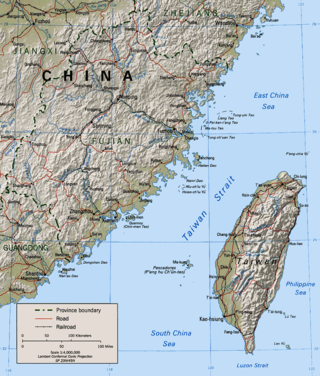
Wade–Giles is a romanization system for Mandarin Chinese. It developed from the system produced by Thomas Francis Wade during the mid-19th century, and was given completed form with Herbert Giles's A Chinese–English Dictionary (1892).

In linguistics, romanization is the conversion of text from a different writing system to the Roman (Latin) script, or a system for doing so. Methods of romanization include transliteration, for representing written text, and transcription, for representing the spoken word, and combinations of both. Transcription methods can be subdivided into phonemic transcription, which records the phonemes or units of semantic meaning in speech, and more strict phonetic transcription, which records speech sounds with precision.

The Linguistic Society of Hong Kong Cantonese Romanization Scheme, also known as Jyutping, is a romanisation system for Cantonese developed in 1993 by the Linguistic Society of Hong Kong (LSHK).
The romanization of Korean is the use of the Latin script to transcribe the Korean language.
JSL is a romanization system for transcribing the Japanese language into the Latin script. It was devised by Eleanor Jorden for her 1987 book Japanese: The Spoken Language. The system is based on Kunrei-shiki romanization. Japanese Yale is a less well-known alternative name for the JSL system.
Som, SOM or Søm may refer to:
Cantonese is the traditional prestige variety of Yue Chinese, a Sinitic language belonging to the Sino-Tibetan language family, which has over 85 million native speakers. It originated in the city of Guangzhou and its surrounding Pearl River Delta. While the term Cantonese specifically refers to the prestige variety, in linguistics it has often been used to refer to the entire Yue subgroup of Chinese, including related but partially mutually intelligible varieties like Taishanese.
The Institute of Language in Education Scheme also known as the List of Cantonese Pronunciation of Commonly-used Chinese Characters romanization scheme (常用字廣州話讀音表), ILE scheme, and Cantonese Pinyin, is a romanization system for Cantonese developed by Ping-Chiu Thomas Yu in 1971, and subsequently modified by the Education Department of Hong Kong and Zhan Bohui (詹伯慧) of the Chinese Dialects Research Centre of the Jinan University, Guangdong, PRC, and honorary professor of the School of Chinese, University of Hong Kong. It is the only romanization system accepted by Education and Manpower Bureau of Hong Kong and Hong Kong Examinations and Assessment Authority.
Pinyin is the official romanization system for Standard Chinese in China, Singapore and, since 2009, Taiwan.
The Myanmar Language Commission Transcription System (1980), also known as the MLC Transcription System (MLCTS), is a transliteration system for rendering Burmese in the Latin alphabet. It is loosely based on the common system for romanization of Pali, has some similarities to the ALA-LC romanization and was devised by the Myanmar Language Commission. The system is used in many linguistic publications regarding Burmese and is used in MLC publications as the primary form of romanization of Burmese.
Latinisation or Latinization can refer to:
The Yale romanization of Cantonese was developed by Yale scholar Gerard P. Kok for his and Parker Po-fei Huang's textbook Speak Cantonese initially circulated in looseleaf form in 1952 but later published in 1958. Unlike the Yale romanization of Mandarin, it is still widely used in books and dictionaries, especially for foreign learners of Cantonese. It shares some similarities with Hanyu Pinyin in that unvoiced, unaspirated consonants are represented by letters traditionally used in English and most other European languages to represent voiced sounds. For example, is represented as b in Yale, whereas its aspirated counterpart, is represented as p. Students attending The Chinese University of Hong Kong's New-Asia Yale-in-China Chinese Language Center are taught using Yale romanization.

Romanization of Chinese is the use of the Latin alphabet to transliterate Chinese. Chinese uses a logographic script and its characters do not represent phonemes directly. There have been many systems using Roman characters to represent Chinese throughout history. Linguist Daniel Kane wrote, "It used to be said that sinologists had to be like musicians, who might compose in one key and readily transcribe into other keys." The dominant international standard for Standard Mandarin since about 1982 has been Hanyu Pinyin, invented by a group of Chinese linguists, including Zhou Youguang, in the 1950s. Other well-known systems include Wade–Giles and Yale romanization.
Yale is a university in the United States.
The former State Administration of Surveying and Mapping, Geographical Names Committee and former Script Reform Committee of the People's Republic of China have adopted several romanizations for Chinese, Mongolian, Tibetan and Uyghur, officially known as pinyin, Regulation of Phonetic Transcription in Hanyu Pinyin Letters of Place Names in Minority Nationality Languages and Orthography of Chinese Personal Name in Hanyu Pinyin Letters. These systems may be referred to as SASM/GNC/SRC transcriptions or SASM/GNC romanizations.
The Yale romanization of Mandarin is a system for transcribing the sounds of Standard Chinese, based on the Beijing dialect of Mandarin. It was devised in 1943 by the Yale sinologist George Kennedy for a course teaching Chinese to American soldiers, and was popularized by continued development of that course at Yale. The system approximated Chinese sounds using English spelling conventions, in order to accelerate acquisition of correct pronunciation by English speakers.
This page is based on this
Wikipedia article Text is available under the
CC BY-SA 4.0 license; additional terms may apply.
Images, videos and audio are available under their respective licenses.


